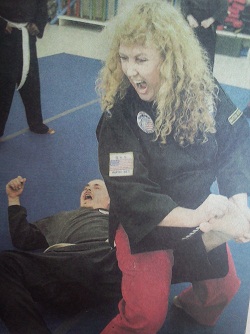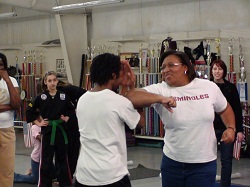 Every person deserves the right to feel safe. That feeling comes from within. Through knowledge of how to be aware of your surrounding, the ability to assess a situation and the choice of which action to take in each circumstance creates a safer personal environment. Many people teach self defense as I do in my UPKUDO karate classes but there are times when people do not want the martial arts nor feel they can perform the techniques.
Every person deserves the right to feel safe. That feeling comes from within. Through knowledge of how to be aware of your surrounding, the ability to assess a situation and the choice of which action to take in each circumstance creates a safer personal environment. Many people teach self defense as I do in my UPKUDO karate classes but there are times when people do not want the martial arts nor feel they can perform the techniques.
My personal safety training is designed to work with people of all ages regardless of ability. For those who are elderly or have physcial restrictions, there are ways to help you remain safe. There is no "perfect" self defense move only the ones that work for you and that makes it very personal. "Perfect" or "best" self defense is the one that works that you can perform!
Growing up, I was always afraid and had little control of the ways things unfolded. When I became an adult some choices and situations were not healthy for me to be in. Through knowledge and Gods guiding hand, I learned how the three aspects I teach can help prevent someone from being in a situation that is not favorable and help them make better decisions in how they choose to deal with their attacker. The power lies not in the hands of your mental or physical attacker but rather in us.

In my seminars you will learn different ways of thinking and actions to take. I speak and teach from personal experience of what it feels like to be beaten, raped and abused by those who were suppose to love me. In my former marriage and workplace, I was the target of someone's else's anger and insecurities. There is hope for those who wish to free themselves from the bondage of abuse and painful experiences.
I am not a doctor nor do I think people should forego seeing those professionally trained to deal with the damages inflicted on them. However, I do feel that by being taught by a person who has evolved from being a victim to a victor, can help shed light on the way you see things. It creates hope and plants the seed of security that grows as knowledge grows.
Perspectives are sometimes distorted. And truth often times is hidden so deep in the heart, it has a hard time coming to the surface. Compassion is what I developed for people, not judging, courage, not fear, and love that can only come from God that heals all wounds.

This website has been developed to help those who are hurting and prove that while the odds may seem to be against you, we can do all things through Christ which strengthens us. I pray that every hurting or fearful soul reaps benefits from reading this site. I realize that some are too embarrassed or ashamed to ever go to someone in person or participate in a training session because that is the way I was for many years. Hopefully the articles located under Articles that God has laid on my heart to write will help you.
If you have a group that needs or wants the personal safety training, click here for an outline of what will be taught and contact mastertrainer@anneradke.com or call 850-566-4544 to schedule a session. Fees are based on location and length of training you desire.



